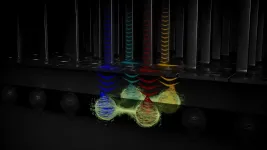Semiconductor qubits scale in two dimensions
2021-03-24
(Press-News.org) The heart of any computer, its central processing unit, is built using semiconductor technology, which is capable of putting billions of transistors onto a single chip. Now, researchers from the group of Menno Veldhorst at QuTech, a collaboration between TU Delft and TNO, have shown that this technology can be used to build a two-dimensional array of qubits to function as a quantum processor. Their work, a crucial milestone for scalable quantum technology, was published today in Nature.
Quantum computers have the potential to solve problems that are impossible to address with classical computers. Whereas current quantum devices hold tens of qubits - the basic building block of quantum technology - a future universal quantum computer capable of running any quantum algorithm will likely consist of millions to billions of qubits. Quantum dot qubits hold the promise to be a scalable approach as they can be defined using standard semiconductor manufacturing techniques. Veldhorst: 'By putting four such qubits in a two-by-two grid, demonstrating universal control over all qubits, and operating a quantum circuit that entangles all qubits, we have made an important step forward in realizing a scalable approach for quantum computation.'
An entire quantum processor
Electrons trapped in quantum dots, semiconductor structures of only a few tens of nanometres in size, have been studied for more than two decades as a platform for quantum information. Despite all promises, scaling beyond two-qubit logic has remained elusive. To break this barrier, the groups of Menno Veldhorst and Giordano Scappucci decided to take an entirely different approach and started to work with holes (i.e. missing electrons) in germanium. Using this approach, the same electrodes needed to define the qubits could also be used to control and entangle them. 'No large additional structures have to be added next to each qubit such that our qubits are almost identical to the transistors in a computer chip,' says Nico Hendrickx, graduate student in the group of Menno Veldhorst and first author of the article. 'Furthermore, we have obtained excellent control and can couple qubits at will, allowing us to program one, two, three, and four-qubit gates, promising highly compact quantum circuits.'
2D is key
After successfully creating the first germanium quantum dot qubit in 2019, the number of qubits on their chips has doubled every year. 'Four qubits by no means makes a universal quantum computer, of course,' Veldhorst says. 'But by putting the qubits in a two-by-two grid we now know how to control and couple qubits along different directions.' Any realistic architecture for integrating large numbers of qubits requires them to be interconnected along two dimensions.
Germanium as a highly versatile platform
Demonstrating four-qubit logic in germanium defines the state-of-the-art for the field of quantum dots and marks an important step toward dense, and extended, two-dimensional semiconductor qubit grids. Next to its compatibility with advanced semiconductor manufacturing, germanium is also a highly versatile material. It has exciting physics properties such as spin-orbit coupling and it can make contact to materials like superconductors. Germanium is therefore considered as an excellent platform in several quantum technologies. Veldhorst: 'Now that we know how to manufacture germanium and operate an array of qubits, the germanium quantum information route can truly begin.'
INFORMATION:
[Attachments] See images for this press release:

ELSE PRESS RELEASES FROM THIS DATE:
2021-03-24
HOUSTON ? Overcoming previous technical challenges with single-cell DNA (scDNA) sequencing, a group led by researchers at The University of Texas MD Anderson Cancer Center has developed a novel method for scDNA sequencing at single-molecule resolution. This technique revealed for the first time that triple-negative breast cancers undergo continued genetic copy number changes after an initial burst of chromosome instability.
The findings, published today in Nature, offer an accurate and efficient new approach for sequencing hundreds of individual cancer cells while also providing novel insights into cancer evolution. These insights may explain why treatments are ...
2021-03-24
Joint press release by the German Cancer Research Center, University Medicine Mannheim, Heidelberg University Hospital, and the National Center for Tumor Diseases (NCT) Heidelberg
Tumor vaccines can help the body fight cancer. Mutations in the tumor genome often lead to protein changes that are typical of cancer. A vaccine can alert the patients' immune system to these mutated proteins. For the first time, physicians and cancer researchers from Heidelberg and Mannheim have now carried out a clinical trial to test a mutation-specific vaccine against malignant brain tumors. The vaccine proved to be safe and triggered the desired immune response in the tumor tissue, as the team now reports in the journal Nature.
Diffuse ...
2021-03-24
Researchers have developed experimental flu shots that protect animals from a wide variety of seasonal and pandemic influenza strains. The vaccine product is currently being advanced toward clinical testing. If proven safe and effective, these next-generation influenza vaccines may replace current seasonal options by providing protection against many more strains that current vaccines do not adequately cover.
A study detailing how the new flu vaccines were designed and how they protect mice, ferrets, and nonhuman primates appears in the March 24 edition of the journal Nature. This work was led by researchers at the University of Washington School of Medicine and the Vaccine
Research Center part of the National Institute of Allergy ...
2021-03-24
Many children of low-income families across the country do not have access to quality health care. Lack of health care can have a domino effect, affecting educational outcomes in the classroom.
School-based telehealth could offer a sustainable and effective solution, according to a new report in the Journal for Nurse Practitioners by Kathryn King Cristaldi, M.D., the medical director of the school-based telehealth program, and Kelli Garber, the lead advanced practice provider and clinical integration specialist for the program.
The program through the MUSC Health Center for Telehealth has effectively served over 70 schools across the state of South Carolina. Evaluating a child at school via telehealth ...
2021-03-24
Probiotics -- those bacteria that are good for your digestive tract -- are short-lived, rarely taking residence or colonizing the gut. But a new study from researchers at the University of California, Davis, finds that in breast milk-fed babies given the probiotic B. infantis, the probiotic will persist in the baby's gut for up to one year and play a valuable role in a healthy digestive system. The study was published in the journal Pediatric Research.
"The same group had shown in a previous study that giving breast milk-fed babies B. infantis had beneficial effects that lasted up to 30 days after supplementation, but this is the first study to show persistent colonization up to 1 year of age," said lead author Jennifer Smilowitz with the UC Davis Department ...
2021-03-24
Non-alcoholic steatohepatitis (NASH), often called 'fatty liver hepatitis', can lead to serious liver damage and liver cancer. A team of researchers at the Technical University of Munich (TUM) has discovered that this condition is caused by cells that attack healthy tissue - a phenomenon known as auto-aggression. Their results may help in the development of new therapies to avoid the consequences of NASH.
Fatty liver disease (NASH) is often associated with obesity. However, our understanding of the causes has been very limited. A team working with ...
2021-03-24
Rich false memories of autobiographical events can be planted - and then reversed, a new paper has found.
The study highlights - for the first time - techniques that can correct false recollections without damaging true memories. It is published by researchers from the University of Portsmouth, UK, and the Universities of Hagen and Mainz, Germany.
There is plenty of psychological research which shows that memories are often reconstructed and therefore fallible and malleable. However, this is the first time research has shown that false memories of autobiographical events can be undone.
Studying how memories are created, identified ...
2021-03-24
Infants prefer baby talk in any language, but particularly when it's in a language they're hearing at home.
A unique study of hundreds of babies involving 17 labs on four continents showed that all babies respond more to infant-directed speech -- baby talk -- than they do to adult-directed speech. It also revealed that babies as young as six months can pick up on differences in language around them.
"We were able to compare babies from bilingual backgrounds to babies from monolingual backgrounds, and what seemed to matter the most was the match between the language they ...
2021-03-24
A new study is the first to identify how human brains grow much larger, with three times as many neurons, compared with chimpanzee and gorilla brains. The study, led by researchers at the Medical Research Council (MRC) Laboratory of Molecular Biology in Cambridge, UK, identified a key molecular switch that can make ape brain organoids grow more like human organoids, and vice versa.
The study, published in the journal END ...
2021-03-24
Scientists have genetically engineered immune cells, called myeloid cells, to precisely deliver an anticancer signal to organs where cancer may spread. In a study of mice, treatment with the engineered cells shrank tumors and prevented the cancer from spreading to other parts of the body. The study, led by scientists at the National Cancer Institute's (NCI) Center for Cancer Research, part of the National Institutes of Health (NIH), was published March 24, 2021, in Cell.
"This is a novel approach to immunotherapy that appears to have promise as a potential treatment for metastatic cancer," said the study's leader, Rosandra Kaplan, M.D., of NCI's Center for Cancer Research.
Metastatic cancer--cancer that has spread from its original location to other parts of the body--is notoriously ...
LAST 30 PRESS RELEASES:
[Press-News.org] Semiconductor qubits scale in two dimensions



